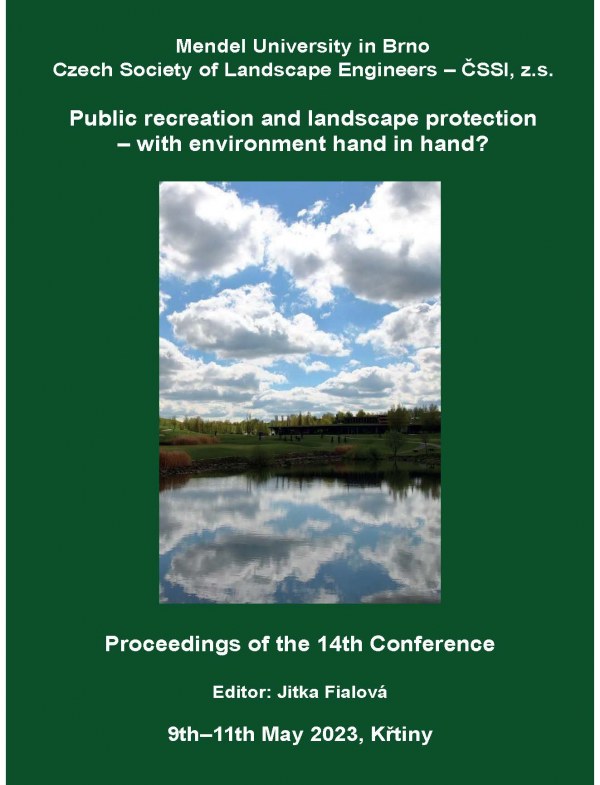
DOI: 10.11118/978-80-7509-904-4-0119
INNOVATIVE TECHNOLOGY OF SAPLINGS PLANTING FOR INCREASE TOURISM POTENTIAL OF THE LANDSCAPE
- Luboš Staněk, Ladislav Zvěřina, Radomír Ulrich
The saplings extractor is intended primarily for replanting all types of seedling forest trees included a bale of soil without disturbing the root system. Trees growing along roads or already grown to a certain extent trees in the landscape are often need to be transplanted due to landscaping or urban planning. These trees can be used, for example, in popular tourist localities, where they can speed up the regeneration of the landscape and make visitors' stay more pleasant. However, this activities shouldn't be provided only manually, but some advanced technologies have to be used. The goal of this paper is presenting a new technology for mechanized planting using the production potential of the seedling trees. The principle of the saplings extractor lies in excavating a pit at the site that will be the subject of tree replanting, and then transplanting the pre-lifted up seedling forest tree into the prepared excavated pit. The last phase is to backfill the pit all around with soil from the excavated pit after the sapling was picked up. This paper emphasise the economic advantages of new technology and provides the saplings planting solutions in the form of landscaping, road tree rows or ornamental trees in an urbanized environment.
Keywords: forest planting, forest regeneration, landscape regeneration, sapling extractor, tree transplanting
pages: 119-122, Published: 2023, online: 2023
References
- Bullock, J. M., Aronson, J., Newton, A. C., Pywell, R. F., Rey-Benayas, J. M. (2011). Restoration of ecosystem services and biodiversity: conflicts and opportunities Trends Ecol. Evol. 26, 541-549.
 Go to original source...
Go to original source... - Cruz-Alonso, V., Ruiz-Benito, P., Villar-Salvador, P., Rey-Benayas, J. M. (2019). Long-term recovery of multifunctionality in mediterranean forests depends on restoration strategy and forest type J. Appl. Ecol., 56, 745-57.
 Go to original source...
Go to original source... - Grossnickle, S. C. (2000). Ecophysiology of Northern spruce species: The performance of planted seedlings. NRC Research.
- Grossnickle, S. C., El-Kassaby, Y. A. (2016). Bareroot versus container stocktypes: a performance comparison. New For., 47(1), 1-51
 Go to original source...
Go to original source... - Matos, F. A. R., Magnago, L. F. S., Aquila Chan Miranda, C., Menezes, L. F. T., Gastauer, M., Safar, N. V. H., Schaefer, C. E. G. R., Silva, M. P., Simonelli, M., Edwards, F. A., Martins, S. V., Meira-Neto, J. A. A., Edwards, D. P. (2020). Secondary forest fragments offer important carbon and biodiversity cobenefits. Global Change Biology, 26(2), 509-522.
 Go to original source...
Go to original source... - Morkovina, S. S., Ivanova, A. V., Seydinay, E. (2019). Tools for supporting forest business that ensure efficient forest management and restoration of forest resources in low-forest regions. Ser.: Earth Environ. Sci., 226, 012040.
 Go to original source...
Go to original source... - Rey Benayas, J. M., Bullock J. M., Newton, A. C. (2008). Creating woodland islets to reconcile ecological restoration, conservation, and agricultural land use. Frontiers Ecol. Environ., 6, 329-336.
 Go to original source...
Go to original source... - Serrano-León, H., Ahtikoski, A., Sonesson, J., Fady, B., Lindner, M., Meredieu, C., Raffin, A., Perret, S., Perot, T., Orazio, C. (2021). From genetic gain to economic gain: simulated growth and financial performance of genetically improved Pinus sylvestris and Pinus pinaster planted stands in France, Finland and Sweden. Forestry: An Int J Forest Res., 94, 512-525.
 Go to original source...
Go to original source... - Shestibratov, K., Baranov, O., Subbotina, N., Lebedev, V., Panteleev, S., Krutovsky, K., Padutov, V. (2018). Early detection and identification of the main fungal pathogens for resistance evaluation of new genotypes of forest trees. Forests, 9(12), 732.
 Go to original source...
Go to original source... - Staněk, L., Hamřík, T., Košulič, O. (2020). Vliv věkové struktury a managementu dubin na epigeické členovce. Zprávy lesnického výzkumu, 65, 265-275.
- Staněk, L., Zvěřina, L., Ulrich, R., Pavlíková, E. A. (2022). A Unique Grubbing Head Prototype for Environmentally Friendly and Sustainable Stump Removal. Forests, 13, 1515.
 Go to original source...
Go to original source... - Wallertz, K., Björklund, N., Hjelm, K., Petersson, M., Sundblad, L.-G. (2018). Comparison of different site preparation techniques: quality of planting spots, seedling growth and pine weevil damage. New For., 49(6), 705-722.
 Go to original source...
Go to original source...


